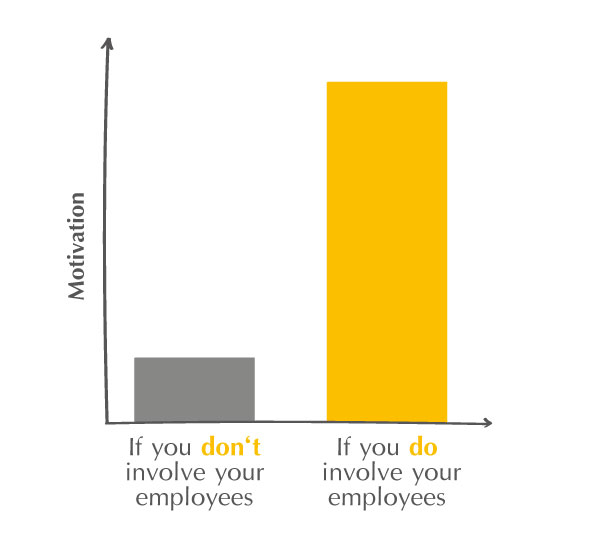To enhance your employees’ willingness to achieve, or to maintain their high-performance level, they should have as comprehensive an idea as possible of what drives you, their leader. At the beginning of this book we described the significance of a leader’s vision and how she should share this spirit with her team, inspiring them to discover their own motivating force.
The leader must marshal her entire team, perhaps her entire company, behind her. She must equip them to follow her down her chosen road. Her only chance of true success is to share her vision and give her colleagues the opportunity to decide for themselves if they wish to take the journey, carrying their share of the vision to its destination. It is highly motivating for an employee when her suggestion is considered, and it leads to process or product improvement.
To enhance your employees’ willingness to achieve, or to maintain their high-performance level, they should have as comprehensive an idea as possible of what drives you, their leader. At the beginning of this book we described the significance of a leader’s vision and how she should share this spirit with her team, inspiring them to discover their own motivating force.
To do so, it is imperative that they know the destination, know exactly what a new project or transition aims to achieve. They must know their boss’s vision and be informed of her strategy. Which market are we approaching? Who is our target group? Which competitors do we have to best? What unique feature are we offering our target group? Tying all this in, objectives are developed to launch these strategies.
The leader must marshal her entire team, perhaps her entire company, behind her. She must equip them to follow her down her chosen road. Her only chance of true success is to share her vision and give her colleagues the opportunity to decide for themselves if they wish to take the journey, carrying their share of the vision to its destination. Is it in alignment with their principles? Do they want the same thing? Do they see the sense in it? If they don’t, they will have to change teams, or maybe even leave the company.
We know from experience how often leaders neglect to speak to their employees about why a certain thing is done. But they should. Co-workers are much more willing to do even unpleasant tasks when they know why it should be done. The terse, “That’s what I pay you for!” has understandably little motivating force behind it. Your employees want to and must know which bigger picture their efforts are serving to assemble.
Participation, however, is not only a mere passing on of information. It is also listening to employees’ ideas (open innovation) and/or giving them the chance to participate in decision-making. In this context, Ken Blanchard and Spencer Johnson speak of the participative leadership concept in their book One Minute Manager.[1] It is highly motivating for an employee when her suggestion is considered, and it leads to process or product improvement.
“Looking at Audi clearly illustrates how those involved know what is best for themselves and their product. […] ›When, for example, upon developing a model, the cup holder is installed too close to the gear box, open innovation can remedy such an error much more quickly. ‹, Oliver Schilling, Audi organizational developer says.”[2]
We sincerely hope the worker catching and correcting this error received proper praise from her boss, inspiring pride and continued eagerness to perform well. No less impressive than admitting a mistake, a leader demonstrates her surety when she can sincerely exclaim, “Many thanks, Mr. Miller, we completely overlooked the proximity to the gear box.”
Subsequently, she couldn’t dream of a more motivated co-worker – Mr. Miller will gladly continue to participate in fulfilling the vision.
Still and all, the leader must always have the last word. She mustn’t run around, pretending to listen to and earnestly consider any and all suggestions. Many suggestions, regardless of their basic viability, are doomed to fail because their implementation is too costly. And this the leader’s responsibility. She must ensure that her decisions are always in the company’s best interest. Participative leadership is not a democracy. There is no majority rule. […]
An excerpt from the book “Leadership Is Not an Illusion – A wealth of adventure, experiences and stories to tell 20 years of consultancy practice” written by Gianni, Jan & Marcello Liscia, 2020
[1] Blanchard, Kenneth et al, _ e One-Minute Manager, Berkeley Trade 1986
[2] sueddeutsche.de, Uns fragt ja niemand! / No one bothers to ask us!, 05.06.2011.




